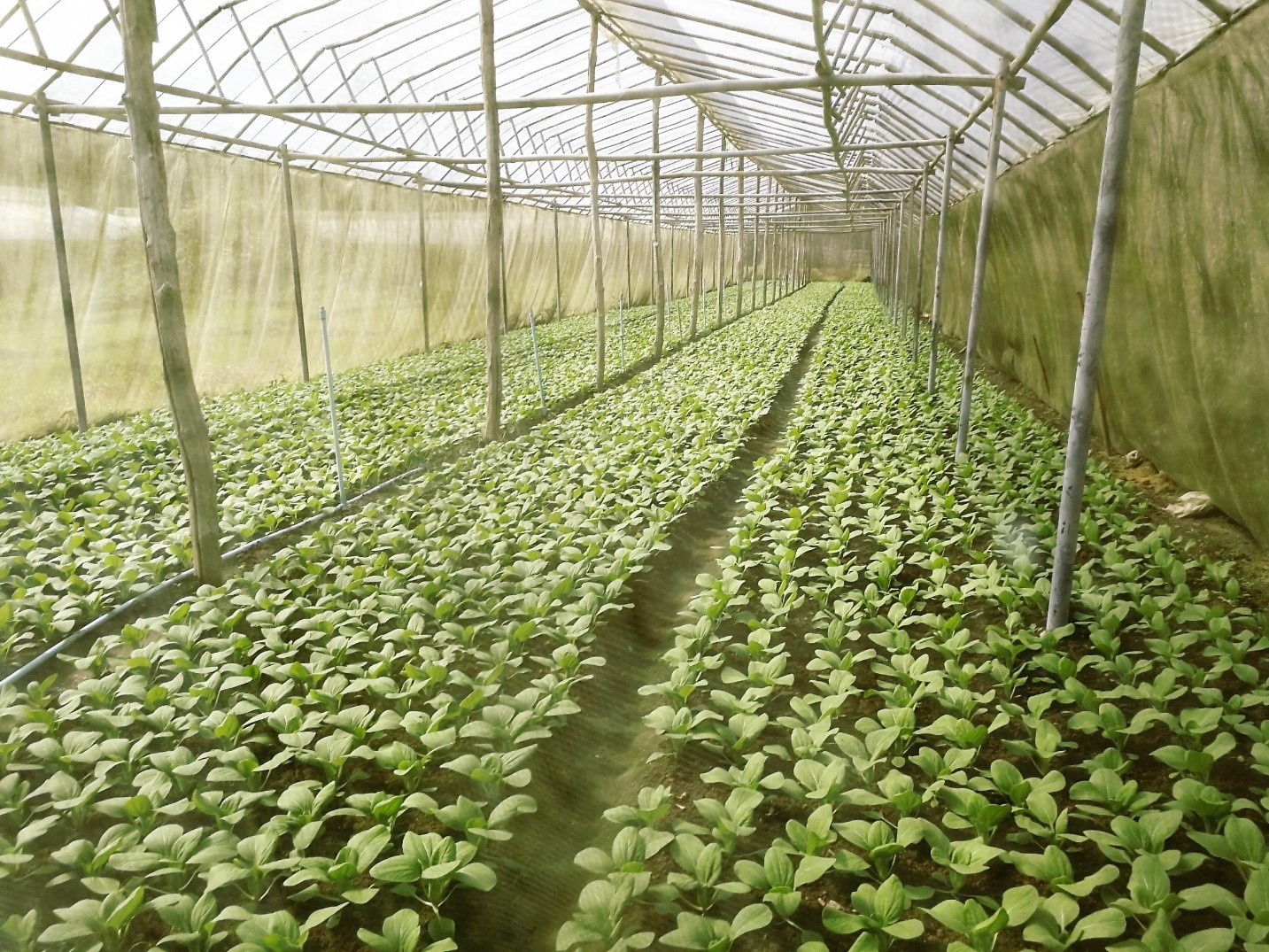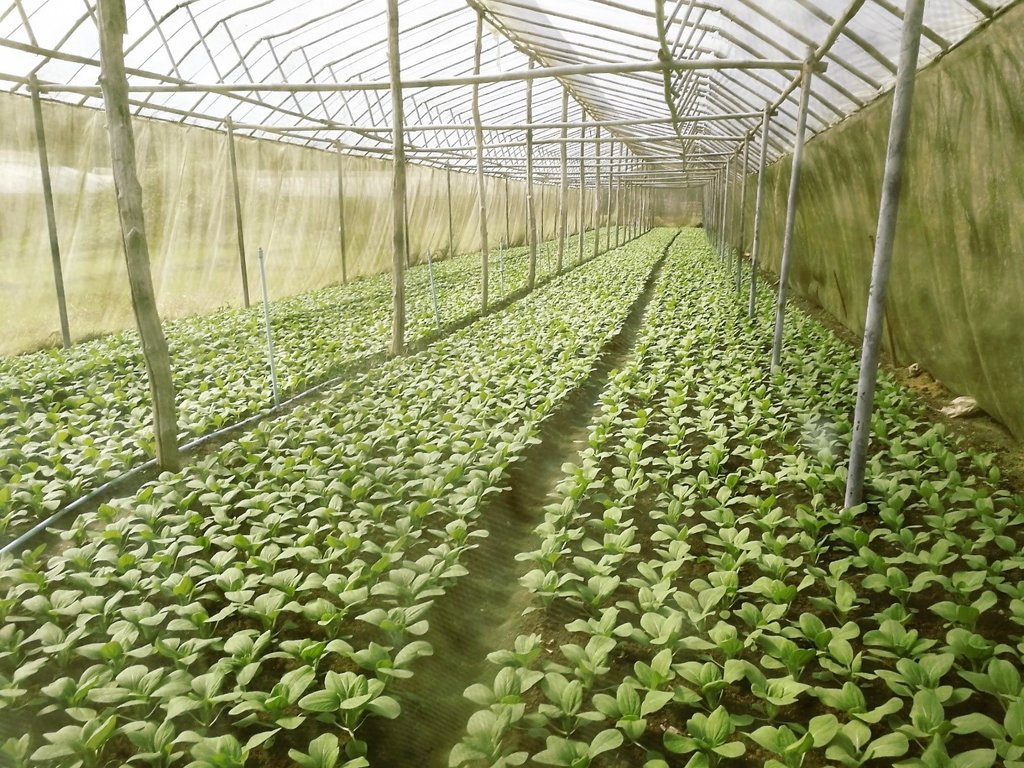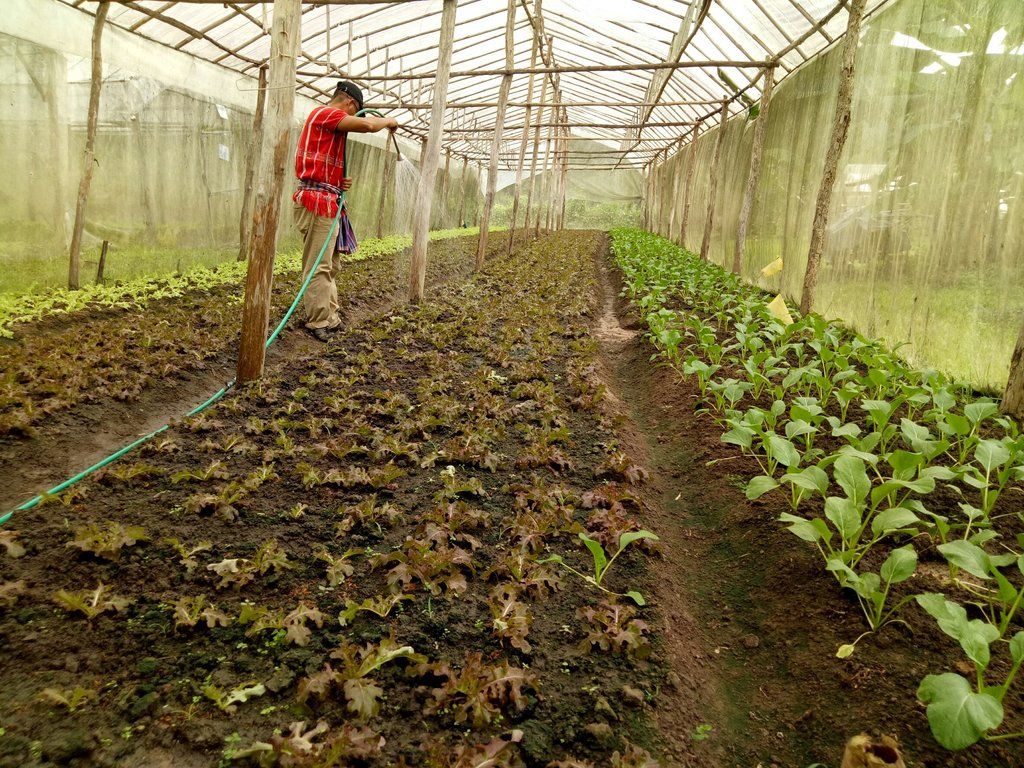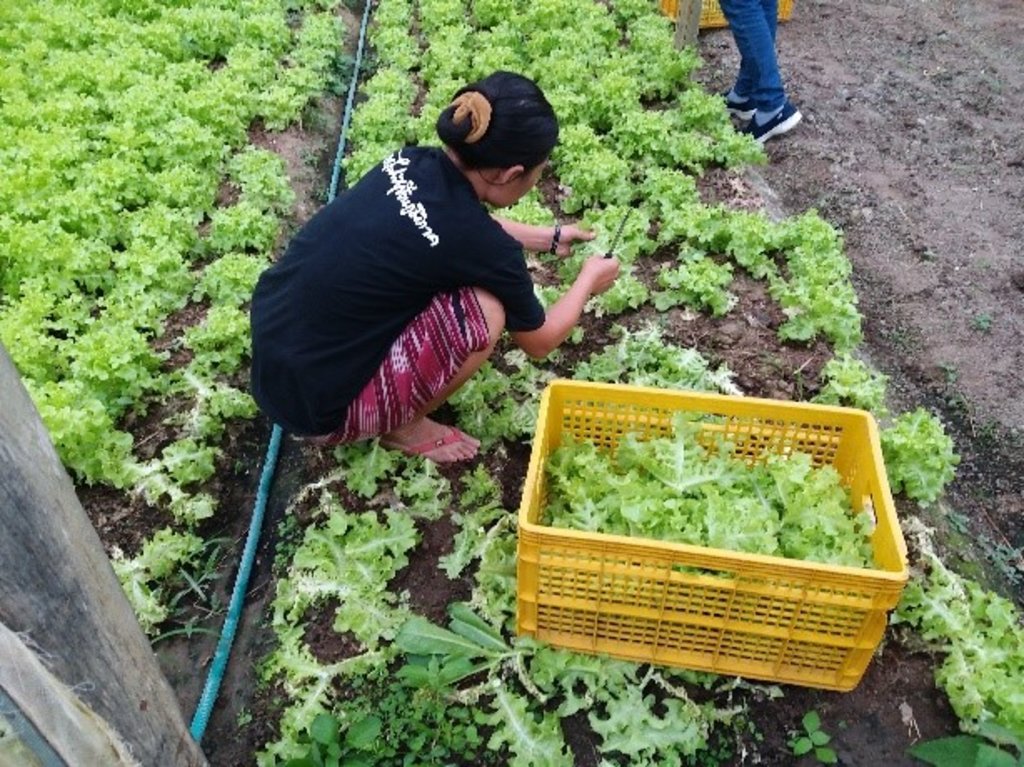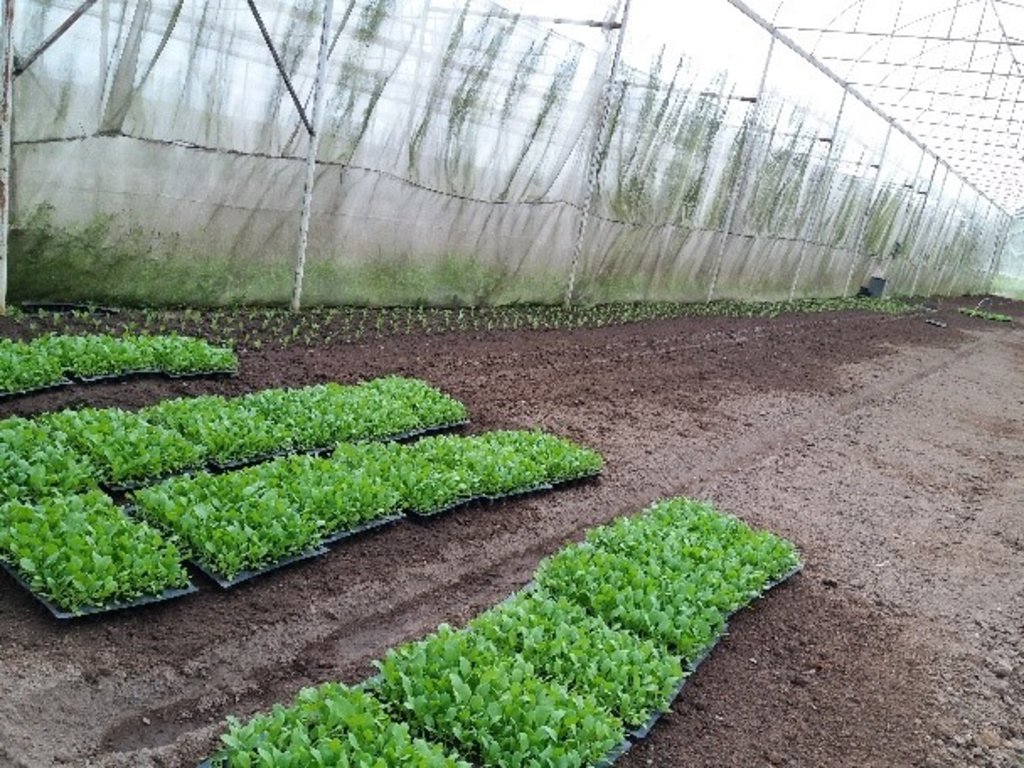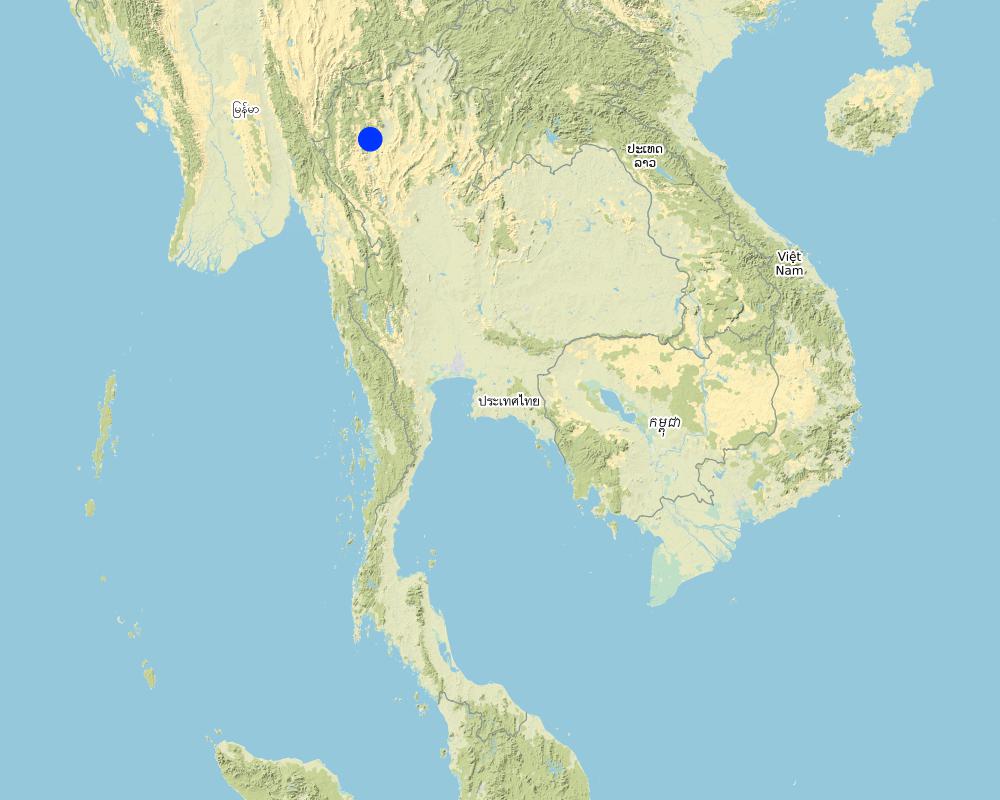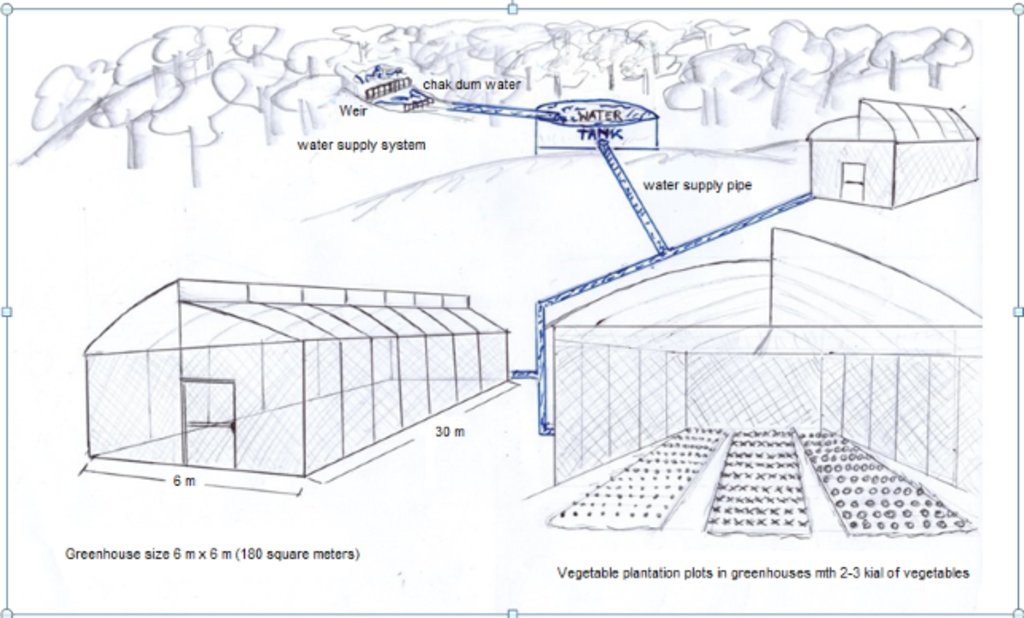Integrated Soil Management for Organic Vegetables on the Highland Watershed in the Northern Region [Thaïlande]
- Création :
- Mise à jour :
- Compilateur : Pitayakon Limtong
- Rédacteur : –
- Examinateurs : Rima Mekdaschi Studer, William Critchley
Organic vegetables in the Royal Project
technologies_4283 - Thaïlande
Voir les sections
Développer tout Réduire tout1. Informations générales
1.2 Coordonnées des personnes-ressources et des institutions impliquées dans l'évaluation et la documentation de la Technologie
Personne(s)-ressource(s) clé(s)
co-compiler:
Wattanaprapat Kamalapa
Land Development Department
Thaïlande
exploitant des terres:
Phojanabandit Watcharin
Headman of village
Thaïlande
local extension officer:
Kerephuwadon Boontre
Inthanon Royal Agricultural Station, the Royal Project
Thaïlande
local LDD officer:
Intha Charun
Royal Project Land Development Center, Land Development Office Region 6, Land Development Department.
Thaïlande
Nom du ou des institutions qui ont facilité la documentation/ l'évaluation de la Technologie (si pertinent)
Land Development Department LDD (Land Development Department LDD) - Thaïlande1.3 Conditions relatives à l'utilisation par WOCAT des données documentées
Le compilateur et la(les) personne(s) ressource(s) acceptent les conditions relatives à l'utilisation par WOCAT des données documentées:
Oui
1.4 Déclaration sur la durabilité de la Technologie décrite
Est-ce que la Technologie décrite ici pose problème par rapport à la dégradation des terres, de telle sorte qu'elle ne peut pas être déclarée comme étant une technologie de gestion durable des terres?
Non
Commentaires:
Organic vegetable production is a technology that prevents and restores land degradation due to soil management emphasized in using organic and natural materials to improve soil fertility and productivity, especially in terms of soil organic matter.
2. Description de la Technologie de GDT
2.1 Courte description de la Technologie
Définition de la Technologie:
Organic vegetable cultivation on the highland area of the northern region of Thailand has been encouraged by local officers in order to produce safe food on degraded land through building up soil fertility and soil organic matter.
2.2 Description détaillée de la Technologie
Description:
This case study is of organic vegetable cultivation at Ban Muang Ang Village which is located in Ban Luang Sub-district, Chom Thong District, Chiang Mai Province, covering approx. 25,881 Rai (6.25 rai = 1 ha; 625 rai = 1 sq km). The topography is a complex mountainous area within the Doi Inthanon National Park, at an elevation of 600-800 m asl. The climate is quite cool and humid with average temperature throughout the year being 20⁰C. The average annual rainfall is 2,000-2,100 mm. Most of the population belong to the Pakhayo hilltribe, living in 219 households, with total population of 588 persons (308 males, 280 females). The main purpose of promoting growing organic vegetables in greenhouses is to change their way of life from forest encroachment/ shifting cultivation in the upper watershed, to improving the ecosystem services and environment with better health and higher incomes for villagers.
Since 2002, the government and the Royal Project Foundation have had a policy to change land use to organic farming. At the early stage, yields of organic vegetables were not good. In the year 2010, the Inthanon Royal Agricultural Station brought a number of these land users to visit the Mae Tho Royal Project Development Center in Bo Sali Sub-district, Hot District, Chiang Mai Province. They obtained knowledge about organic cultivation in simple greenhouses made from bamboo poles, covered with plastic sheets and nylon nets. Local officers of the Inthanon Royal Agricultural Station supported with education, offered suggestions and recommended practices, as well as finding markets to sell the organic products; that became the model. It took only 25-30 days for a crop, and they could harvest about 200 kg of vegetables per greenhouse. They could produce 11 crops of vegetables in one year, which means that they could earn 10 times more income than before. At present, Muang Ang Village there are 153 members operating in 270 greenhouses which is the largest organic vegetable production area in the Inthanon Royal Project.
The production of organic vegetables in this area is outstanding. This network has received certification from the Department of Agriculture (DOA) and the Office of Organic Agriculture Certification Thailand (ACT Organic). Farmers or farming enterprises certified by this system are entitled to apply the logos and certification card of ACT Organic and IFOAM Accredited brand on their products. Moreover, the Agri-Food & Veterinary Authority of Singapore (AVA) has approved the production processes. Every production step has been approved through the standard regulation of each agency with tracking to the source of production inputs such as fertilizers, disease, weed and pest control measures, cultivation practices, etc. Now they have nine types of vegetables that constitute the main production: Choy, Baby Emperor, Cos Salad, Green Oak, Red Oak, Fille Iceberg, String Bean, Kale Hong Kong and Baby Carrot.
2.3 Photos de la Technologie
Remarques générales concernant les photos:
The simple nursery is 6 meters wide, 30 meters long, and 5 meters high. Organic vegetable seed is supported from the Royal Project with ready to planting into the plot.
2.4 Vidéos de la Technologie
Date:
13/09/2018
Lieu:
Moo 9, Ban Mung Aung Village, Ban Luang Sub-district, Chom Thong District, Chiang Mai Province
Nom du vidéaste:
Ms. Kamalapa Wattanaprapat
2.5 Pays/ région/ lieux où la Technologie a été appliquée et qui sont couverts par cette évaluation
Pays:
Thaïlande
Région/ Etat/ Province:
Ban Luang Sub-district, Chom Thong District, Chiang Mai Province
Autres spécifications du lieu:
Inthanon Royal Agricultural Station
Spécifiez la diffusion de la Technologie:
- appliquée en des points spécifiques ou concentrée sur une petite surface
Commentaires:
This activity is the integrated implementation project of the Royal Project in collaboration with other government agencies.
Map
×2.6 Date de mise en œuvre de la Technologie
Indiquez l'année de mise en œuvre:
2002
Si l'année précise est inconnue, indiquez la date approximative: :
- il y a entre 10-50 ans
2.7 Introduction de la Technologie
Spécifiez comment la Technologie a été introduite: :
- par le biais de projets/ d'interventions extérieures
Commentaires (type de projet, etc.) :
All knowledge and technology is supported by the Royal Project collaboration with Land Development Department and other government and private agencies.
3. Classification de la Technologie de GDT
3.1 Principal(aux) objectif(s) de la Technologie
- préserver l'écosystème
- conserver/ améliorer la biodiversité
- créer un impact économique positif
3.2 Type(s) actuel(s) d'utilisation des terres, là où la Technologie est appliquée

Terres cultivées
- Cultures annuelles
Précisez:
Vegetables: Cantonese, Baby Emperor, CosSalad, Oak leaf Green, Oak leaf Red, Guest Bean, Filler Iceberg, Kale Hong Kong and Baby Carrot.

Voies d'eau, plans d'eau, zones humides
Principaux produits/ services:
Irrigation water from a storage tank at the upper part, through PVC pipes to the area cultivated to the organic vegetables.
Commentaires:
In the past, villagers had encroached on forest areas and deforestation in highland for shifting cultivation, and also expand cultivation area into steep slope. Resulting in the destruction of forest areas and accelerated soil degradation. Villagers have low incomes: not enough to survive. But due to the grace of His Majesty King Bhumibol Adulyadej, King Rama 9 set up the Royal Project to distribute knowledge and education to all farmers in this area, and assist them to have better occupation and living standards.
3.3 Est-ce que l’utilisation des terres a changé en raison de la mise en œuvre de la Technologie ?
Commentaires:
The Royal Project has promoted the production of organic vegetables. Farmers therefore have changed from shifting cultivation to organic agriculture with sustainable soil management. As well as returning from forest areas and conserving soil, water and forest resources, maintaining ecological balance, this all makes villagers lives better. According to the cultivation schedule provided by the Royal Project, this area can cultivated throughout the year due to the development of irrigation systems from the storage tank in the upper part and supply to each plot of this targeted area.
3.4 Approvisionnement en eau
autre (par ex., post-inondation):
- water from watershed area
Commentaires:
Water resources are obtained from watercourses in the watershed, with a small dam which collects water in a reservoir. A PVC pipe is connected from the reservoir to individual plots and this irrigation system allows allocation to every farmer by the water management group.
3.5 Groupe de GDT auquel appartient la Technologie
- système de rotation (rotation des cultures, jachères, agriculture itinérante)
- lutte intégrée contre les ravageurs et les maladies (incluant l'agriculture biologique)
- gestion de l'irrigation (incl. l'approvisionnement en eau, le drainage)
3.6 Mesures de GDT constituant la Technologie

pratiques agronomiques
- A2: Matière organique/ fertilité du sol

modes de gestion
- M2: Changement du niveau de gestion / d'intensification
Commentaires:
-
3.7 Principaux types de dégradation des terres traités par la Technologie

érosion hydrique des sols
- Wt: perte de la couche superficielle des sols (couche arable)/ érosion de surface

dégradation chimique des sols
- Cp: pollution des sols

dégradation biologique
- Bl: perte de la vie des sols
- Bp: augmentation des insectes nuisibles (ravageurs)/ maladies, baisse des prédateurs
Commentaires:
Organic vegetable production in greenhouses can solve the problem of soil erosion with utilization of compost, animal and green manure to increase fertility and organic matter.
3.8 Prévention, réduction de la dégradation ou réhabilitation des terres dégradées
Spécifiez l'objectif de la Technologie au regard de la dégradation des terres:
- prévenir la dégradation des terres
- réduire la dégradation des terres
Commentaires:
This organic vegetable production on very steep land can prevent and reduce soil erosion. Moreover, organic material and fertilizers can restore and improve soil fertility and productivity.
4. Spécifications techniques, activités, intrants et coûts de mise en œuvre
4.1 Dessin technique de la Technologie
Spécifications techniques (associées au dessin technique):
Operating procedures
1. Establishment of networks: All land users set up networks of organic vegetable producers and register the members properly; all members must act strictly according to the regulations.
2. Integrated cooperation: The Inthanon Royal Agricultural Station and the Inthanon Highland Agricultural Extension Center organize training on organic farming at least once a year, including study trip/s to visit other successful organic farmers.
3. Selection of the area: Leaders and members select the area for members, each member occupying not more than three greenhouses, 6m wide, 30m long and 3-5m high (180 sq m).
4. Production planning: land users discuss with the staff of the Inthanon Royal Agricultural Station, and plan the production schedule and types of vegetables to meet the market demand.
5. Procurement of production inputs: Both of local officers with inspectors and farmers can buy production inputs by themselves. All materials must be organic and are from reliable sources. Farmers must be very careful in this matter.
6. Organic vegetables cultivation: All land users must strictly comply with the schedule of cultivation, practices in soil improvement, control of pests and diseases, plus recording every step of their activities.
7. Production monitoring: Staffs of the Inthanon Royal Agricultural Station and Department of Agricultural Extension (DOAE) monitor and observe land users’ practices in using soil improvement methods and using bioproducts for controlling insects, predators, parasites and diseases. Department of Agriculture (DOA) and the Organic Agriculture Certification Thailand (ACT Organic) monitor the production process.
8. Harvesting of Products: All land users must harvest according to the harvesting schedule and the preservation methods. DOA and ACT Organic serve as certification agencies by analyzing the contamination of substances in the products.
9. Screening and packing: All land users must clean their products with non-contaminated equipment, and also screen the quality and specified size/s of products for delivery to the Inthanon Royal Agricultural Station.
Auteur:
Ms.Kamalapa Watanaprapat
Date:
25/10/2018
4.2 Informations générales sur le calcul des intrants et des coûts
Spécifiez la manière dont les coûts et les intrants ont été calculés:
- par superficie de la Technologie
Indiquez la taille et l'unité de surface:
70 rai
Si vous utilisez une unité de superficie locale, indiquez le facteur de conversion vers un hectare (p.ex. 1 ha = 2.47 acres): 1 ha = :
1 ha = 6.25 rai
autre/ monnaie nationale (précisez):
Baht (THB)
Indiquez le taux de change des USD en devise locale, le cas échéant (p.ex. 1 USD = 79.9 réal brésilien): 1 USD = :
32,0
Indiquez le coût salarial moyen de la main d'œuvre par jour:
300
4.3 Activités de mise en place/ d'établissement
| Activité | Calendrier des activités (saisonnier) | |
|---|---|---|
| 1. | Establish organic vegetables group | The first year of cultivation |
| 2. | Site selection | Before cultivation |
| 3. | Construct greenhouse or nursery | Before cultivation |
| 4. | Production work plan | Before cultivation |
| 5. | Procurement of production factors | Before cultivation |
| 6. | Soil preparation and improvement | During soil preparation |
| 7. | Vegetables seedling preparation | During soil preparation |
| 8. | Plantation | During vegetables planting |
| 9. | Disease and pest control | During vegetables planting |
| 10. | Vegetable harvesting | During harvesting |
| 11. | Screening and packing | After harvesting |
| 12. | Technology maintenance | After harvesting |
Commentaires:
-
4.4 Coûts et intrants nécessaires à la mise en place
| Spécifiez les intrants | Unité | Quantité | Coûts par unité | Coût total par intrant | % des coût supporté par les exploitants des terres | |
|---|---|---|---|---|---|---|
| Main d'œuvre | Construct greenhouse | man | 10,0 | 300,0 | 3000,0 | 100,0 |
| Main d'œuvre | During cultivation | man | 6,0 | 300,0 | 1800,0 | 100,0 |
| Main d'œuvre | During maintenance | man | 45,0 | 300,0 | 13500,0 | 100,0 |
| Main d'œuvre | During harvesting | man | 10,0 | 300,0 | 3000,0 | 100,0 |
| Equipements | Rubber pipe | piece | 1,0 | 1000,0 | 1000,0 | 100,0 |
| Equipements | Tractor for soil preparation | Rai | 1,0 | 300,0 | 300,0 | 100,0 |
| Matériel végétal | Vegetables seed | site | 1,0 | 700,0 | 700,0 | 100,0 |
| Engrais et biocides | Animal manure (cow manure) | bag | 20,0 | 30,0 | 600,0 | 100,0 |
| Engrais et biocides | BT bio-product | litre | 100,0 | |||
| Engrais et biocides | Predators and parasites | - | ||||
| Engrais et biocides | Insect glue trap | liter | 0,5 | 290,0 | 145,0 | 100,0 |
| Engrais et biocides | Yellow plastic plate | piece | 60,0 | 5,0 | 300,0 | 100,0 |
| Engrais et biocides | Yellow plastic bag | litre | 0,5 | 120,0 | 60,0 | 100,0 |
| Matériaux de construction | Wood frame / mesh net / plastic cloth | site | 1,0 | 14700,0 | 14700,0 | 40,0 |
| Matériaux de construction | PVC pipe | piece | 40,0 | 40,0 | 1600,0 | 100,0 |
| Coût total de mise en place de la Technologie | 40705,0 | |||||
| Coût total de mise en place de la Technologie en dollars américains (USD) | 1272,03 | |||||
Si le coût n'est pas pris en charge à 100% par l'exploitant des terres, indiquez qui a financé le coût restant:
Construction greenhouse cost, land users support 40%, and Organic Vegetable Production Fund support 60% of this cost.
Commentaires:
Labor cost in greenhouse construction, greenhouse materials, which land users would only pay for the first year, but they do not pay for the second year and do not much towards repair cost.
4.5 Activités d'entretien/ récurrentes
| Activité | Calendrier/ fréquence | |
|---|---|---|
| 1. | Changing the plastic sheet of the roof of greenhouse | 3,000 baht per greenhouse every 3 years |
| 2. | Washing the plastic sheet of the greenhouse roof | Once a year |
Commentaires:
-
4.6 Coûts et intrants nécessaires aux activités d'entretien/ récurrentes (par an)
| Spécifiez les intrants | Unité | Quantité | Coûts par unité | Coût total par intrant | % des coût supporté par les exploitants des terres | |
|---|---|---|---|---|---|---|
| Main d'œuvre | Changing plastic sheets | man | 3,0 | 300,0 | 900,0 | 100,0 |
| Main d'œuvre | Wash plastic sheets | man | 3,0 | 300,0 | 900,0 | 100,0 |
| Matériaux de construction | Plastic sheet (change every 3 years) | roll | 1,0 | 3700,0 | 3700,0 | 100,0 |
| Coût total d'entretien de la Technologie | 5500,0 | |||||
| Coût total d'entretien de la Technologie en dollars américains (USD) | 171,88 | |||||
Si le coût n'est pas pris en charge à 100% par l'exploitant des terres, indiquez qui a financé le coût restant:
Land users purchase 100%
Commentaires:
Land users purchase 100%
4.7 Facteurs les plus importants affectant les coûts
Décrivez les facteurs les plus importants affectant les coûts :
The most important factor that affects other costs is seed. Manure must be purchased from standard organic source. The Royal Project provides standard seed, and animal manure must be purchased from other provinces that require natural cultivation farming. The source of the materials used can be traced back to the original provider. Labor factors are not impacted because they can help each other, and land users work together in each greenhouse.
5. Environnement naturel et humain
5.1 Climat
Précipitations annuelles
- < 250 mm
- 251-500 mm
- 501-750 mm
- 751-1000 mm
- 1001-1500 mm
- 1501-2000 mm
- 2001-3000 mm
- 3001-4000 mm
- > 4000 mm
Spécifiez la pluviométrie moyenne annuelle (si connue), en mm:
1500,00
Spécifications/ commentaires sur les précipitations:
Rainy season is from June - October
Indiquez le nom de la station météorologique de référence considérée:
Inthanon Royal Project Meteorological Station
Zone agro-climatique
- subhumide
-
5.2 Topographie
Pentes moyennes:
- plat (0-2 %)
- faible (3-5%)
- modéré (6-10%)
- onduleux (11-15%)
- vallonné (16-30%)
- raide (31-60%)
- très raide (>60%)
Reliefs:
- plateaux/ plaines
- crêtes
- flancs/ pentes de montagne
- flancs/ pentes de colline
- piémonts/ glacis (bas de pente)
- fonds de vallée/bas-fonds
Zones altitudinales:
- 0-100 m
- 101-500 m
- 501-1000 m
- 1001-1500 m
- 1501-2000 m
- 2001-2500 m
- 2501-3000 m
- 3001-4000 m
- > 4000 m
Indiquez si la Technologie est spécifiquement appliquée dans des:
- situations convexes
Commentaires et précisions supplémentaires sur la topographie:
Most of the area is mountainous slope complex, with a steep slope and attitude is 1,200-1,400 meters above sea level. The forest condition is good, and some areas of the Doi Inthanon is national park and some is in national forest reserve.
5.3 Sols
Profondeur moyenne du sol:
- très superficiel (0-20 cm)
- superficiel (21-50 cm)
- modérément profond (51-80 cm)
- profond (81-120 cm)
- très profond (>120 cm)
Texture du sol (de la couche arable):
- moyen (limoneux)
Texture du sol (> 20 cm sous la surface):
- grossier/ léger (sablonneux)
Matière organique de la couche arable:
- moyen (1-3%)
Si disponible, joignez une description complète du sol ou précisez les informations disponibles, par ex., type de sol, pH/ acidité du sol, capacité d'échange cationique, azote, salinité, etc.
Soil pH is 5.5-6.0
5.4 Disponibilité et qualité de l'eau
Profondeur estimée de l’eau dans le sol:
> 50 m
Disponibilité de l’eau de surface:
bonne
Qualité de l’eau (non traitée):
uniquement pour usage agricole (irrigation)
La salinité de l'eau est-elle un problème? :
Non
La zone est-elle inondée?
Non
Commentaires et précisions supplémentaires sur la qualité et la quantité d'eau:
Water flows from the watershed area of the upper forest, and not flow through the conventional agricultural area.
5.5 Biodiversité
Diversité des espèces:
- moyenne
Diversité des habitats:
- moyenne
Commentaires et précisions supplémentaires sur la biodiversité:
Biodiversity in this area has a variety of insects. There are both pests and predators.
5.6 Caractéristiques des exploitants des terres appliquant la Technologie
Sédentaire ou nomade:
- Sédentaire
Orientation du système de production:
- exploitation mixte (de subsistance/ commerciale)
Revenus hors exploitation:
- 10-50% de tous les revenus
Niveau relatif de richesse:
- moyen
Individus ou groupes:
- groupe/ communauté
Niveau de mécanisation:
- travail manuel
Genre:
- femmes
- hommes
Age des exploitants des terres:
- jeunes
- personnes d'âge moyen
- personnes âgées
Indiquez toute autre caractéristique pertinente des exploitants des terres:
Land users can cultivate organic vegetables and earning more income, where young generation in the village become interested and help their families to cultivate organic vegetables. Moreover these young generation who have graduated from university like to become farmers and do not leave to other occupations.
5.7 Superficie moyenne des terres utilisées par les exploitants des terres appliquant la Technologie
- < 0,5 ha
- 0,5-1 ha
- 1-2 ha
- 2-5 ha
- 5-15 ha
- 15-50 ha
- 50-100 ha
- 100-500 ha
- 500-1 000 ha
- 1 000-10 000 ha
- > 10 000 ha
Cette superficie est-elle considérée comme de petite, moyenne ou grande dimension (en se référant au contexte local)?
- moyenne dimension
Commentaires:
Most land users have an average land of 20 rai, consisting of 3-5 rai for rice fields, and 10-15 rai of rotation cultivation. They do not have right in landownership because all of these land are in the reserved forest area and national park. But they have right in utilize their land under the Royal Project.
5.8 Propriété foncière, droits d’utilisation des terres et de l'eau
Propriété foncière:
- individu, sans titre de propriété
Droits d’utilisation des terres:
- communautaire (organisé)
Droits d’utilisation de l’eau:
- communautaire (organisé)
Précisez:
-
Commentaires:
Land users in this area are Lawa hill tribe who migrated from different places to settle here. The main occupation is agriculture under crop rotation, some harvesting of forest products, and some animals. They have not right in landownership but they have right to utilize their land and water for agricultural activities under the Royal Project.
5.9 Accès aux services et aux infrastructures
santé:
- pauvre
- modéré
- bonne
éducation:
- pauvre
- modéré
- bonne
assistance technique:
- pauvre
- modéré
- bonne
emploi (par ex. hors exploitation):
- pauvre
- modéré
- bonne
marchés:
- pauvre
- modéré
- bonne
énergie:
- pauvre
- modéré
- bonne
routes et transports:
- pauvre
- modéré
- bonne
eau potable et assainissement:
- pauvre
- modéré
- bonne
services financiers:
- pauvre
- modéré
- bonne
Average debt 20,000 baht per person:
- pauvre
- modéré
- bonne
Commentaires:
-
6. Impacts et conclusions
6.1 Impacts sur site que la Technologie a montrés
Impacts socio-économiques
Production
production agricole
Commentaires/ spécifiez:
Land users can cultivate 11 times per year.
qualité des cultures
Commentaires/ spécifiez:
GAP and organic products
qualité des forêts/ bois
Commentaires/ spécifiez:
Reforestation in this area, around 1,700 rai
risque d'échec de la production
Commentaires/ spécifiez:
Land users can cultivate continuously and local officers visit and advise them for good practices under GAP and organic agriculture.
diversité des produits
surface de production
Commentaires/ spécifiez:
Area for agriculture decreased and forest area increased. That corresponds to the policy of the Royal Project to produce strictly organic vegetables.
Disponibilité et qualité de l'eau
demande pour l'eau d'irrigation
Commentaires/ spécifiez:
Membership in this network increased by 3-4 persons a year.
Revenus et coûts
dépenses pour les intrants agricoles
Commentaires/ spécifiez:
Cost of fertilizers, bioproduct and pesticides
revenus agricoles
Commentaires/ spécifiez:
GAP and organic vegetable products
charge de travail
Commentaires/ spécifiez:
They usually work in their land almost everyday because organic vegetables need more intensive practices.
Impacts socioculturels
sécurité alimentaire/ autosuffisance
Commentaires/ spécifiez:
That is the main concept of the organic vegetable activities.
situation sanitaire
possibilités de loisirs
institutions communautaires
Commentaires/ spécifiez:
The Royal Project officers supported knowledge and suggestion to community network.
institutions nationales
connaissances sur la GDT/ dégradation des terres
Commentaires/ spécifiez:
Local officers and training in implementation
apaisement des conflits
situation des groupes socialement et économiquement désavantagés
Impacts écologiques
Cycle de l'eau/ ruissellement
quantité d'eau
Commentaires/ spécifiez:
Rainwater from the upstream of this watershed
Sols
humidité du sol
couverture du sol
perte en sol
encroûtement/ battance du sol
compaction du sol
matière organique du sol/ au dessous du sol C
Commentaires/ spécifiez:
They usually use organic fertilizers.
Biodiversité: végétale, animale
Couverture végétale
diversité végétale
Commentaires/ spécifiez:
Several kinds of vegetables are used in this organic farming.
espèces étrangères envahissantes
diversité animale
espèces bénéfiques
contrôle des animaux nuisibles/ maladies
Commentaires/ spécifiez:
They used bioproducts for disease and pest control.
Réduction des risques de catastrophe et des risques climatiques
impacts des cyclones, pluies torrentielles
Précisez l'évaluation des impacts sur site (sous forme de mesures):
The main objective of organic vegetables cultivation is to increase their income and produce green vegetable products, they can work throughout the year with higher income with the less of area.
6.2 Impacts hors site que la Technologie a montrés
disponibilité de l'eau
flux des cours d'eau fiables et stables en saison sèche
pollution des rivières/ nappes phréatiques
dommages sur les champs voisins
impact des gaz à effet de serre
Précisez l'évaluation des impacts extérieurs (sous forme de mesures):
Moreover, land users in the upstream area would cultivate in organic vegetables with bioproducts of disease and pest control, where it would safe to the downstream area.
6.3 Exposition et sensibilité de la Technologie aux changements progressifs et aux évènements extrêmes/catastrophes liés au climat (telles que perçues par les exploitants des terres)
Changements climatiques progressifs
Changements climatiques progressifs
| Saison | Augmentation ou diminution | Comment la Technologie fait-elle face à cela? | |
|---|---|---|---|
| températures annuelles | modérément | ||
| températures saisonnières | été | pas bien | |
| températures saisonnières | saison des pluies/ humide | bien | |
| températures saisonnières | hiver | bien | |
| précipitations annuelles | bien |
Extrêmes climatiques (catastrophes)
Catastrophes météorologiques
| Comment la Technologie fait-elle face à cela? | |
|---|---|
| pluie torrentielle locale | modérément |
| orage local | modérément |
Catastrophes biologiques
| Comment la Technologie fait-elle face à cela? | |
|---|---|
| maladies épidémiques | pas bien du tout |
| infestation par des insectes/ vers | pas bien du tout |
Commentaires:
-
6.4 Analyse coûts-bénéfices
Quels sont les bénéfices comparativement aux coûts de mise en place (du point de vue des exploitants des terres)?
Rentabilité à long terme:
très positive
Quels sont les bénéfices comparativement aux coûts d'entretien récurrents (du point de vue des exploitants des terres)?
Rentabilité à long terme:
très positive
6.5 Adoption de la Technologie
- > 50%
Si disponible, quantifiez (nombre de ménages et/ou superficie couverte):
Land users are 153 members, with 270 greenhouses
De tous ceux qui ont adopté la Technologie, combien d'entre eux l'ont fait spontanément, à savoir sans recevoir aucune incitation matérielle, ou aucune rémunération? :
- 0-10%
Commentaires:
In the first stage some of land user cultivated organic vegetables without greenhouses, then they lost their grain. After they had train and study trip, they improve their implement and construct greenhouse.
6.6 Adaptation
La Technologie a-t-elle été récemment modifiée pour s'adapter à l'évolution des conditions?
Non
6.7 Points forts/ avantages/ possibilités de la Technologie
| Points forts/ avantages/ possibilités du point de vue de l'exploitant des terres |
|---|
| Promoting occupation and income earning of land users in this area. |
| All land users have been well trained; they receive consistent knowledge and suggestions from local officers and several agencies. |
| All land users produce certified organic vegetables that are green and are sold as organic food in the market. |
| They established the community enterprises of organic vegetables producer group. |
| Points forts/ avantages/ possibilités du point de vue du compilateur ou d'une autre personne ressource clé |
|---|
| Encouraging organic vegetable production is the activity of the government and the Royal Project in order to conserve this highland area with the intensive management. |
| Members of the land users community trust and assist each other with willingness to share the knowledge and experience in organic farming practices. |
| As a model of self-sufficient agriculture, they should have more income from the sustainable use of their land. |
| Establish and strengthen the community network to carry out and extend to others in this area. |
6.8 Faiblesses/ inconvénients/ risques de la Technologie et moyens de les surmonter
| Faiblesses/ inconvénients/ risques du point de vue de l’exploitant des terres | Comment peuvent-ils être surmontés? |
|---|---|
| They are allowed to use the land for cultivating organic vegetables. | The government policy needs to have stability and consistency in using this land for a long time. |
| They need educational opportunity for their children. | The government needs to set up more schools in this area, and also to provide more chance to study in the higher level. |
| They need to have opportunity to access energy resources, especially in electricity. | Provincial Electricity Authority (PEA) has allocated budget for installing small electrical systems. |
| Transportation and road conditions are not convenient to access this area. | Local administrative organizations should be allocated more budget to develop such infrastructure. |
| Faiblesses/ inconvénients/ risques du point de vue du compilateur ou d'une autre personne ressource clé | Comment peuvent-ils être surmontés? |
|---|---|
| They do not have land ownership but they are allowed to use their land. | The government has a policy to "Issue a community land title deed" to solve this problem. |
| Almost of them cannot produce such as manure, compost, insect repellents by themselves. | Local officers have supported the knowledge and financial advice. |
| Almost of them cannot find organic product market by themselves. | establishment their cooperatives or network to promote in marketing. |
7. Références et liens
7.1 Méthodes/ sources d'information
- visites de terrain, enquêtes sur le terrain
4
- interviews/entretiens avec les exploitants des terres
1
- compilation à partir de rapports et d'autres documents existants
2
Commentaires:
-
7.2 Références des publications disponibles
Titre, auteur, année, ISBN:
-
Disponible à partir d'où? Coût?
-
7.3 Liens vers les informations pertinentes en ligne
Titre/ description:
The North attitude: Ang village cultivate vegetables to the forest
URL:
https://www.youtube.com/watch?v=dKLG2ImGwDE
Titre/ description:
Organic vegetables at Ang village, Joam Tong Sub-district
URL:
https://www.youtube.com/watch?v=ALL9jJYzVyI
Titre/ description:
Regional 4.0: ภูมิภาค 3.0: Ang village cultivate vegetables to the forest
URL:
https://www.youtube.com/watch?v=6u02SB_53IM
7.4 Observations d'ordre général
-
Liens et modules
Développer tout Réduire toutLiens
Aucun lien
Modules
Aucun module trouvé


